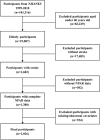Association of neutrophil-percentage-to-albumin ratio with mortality in older stroke survivors
- PMID: 40520535
- PMCID: PMC12162721
- DOI: 10.3389/fnagi.2025.1611289
Association of neutrophil-percentage-to-albumin ratio with mortality in older stroke survivors
Abstract
Background: The neutrophil-percentage-to-albumin ratio (NPAR) functions as an integrative marker representing inflammatory response and nutritional health. However, its association with mortality in elderly stroke survivors has not been explored.
Methods: This cohort study analyzed data from 1,026 elderly stroke survivors in the National Health and Nutrition Examination Survey (NHANES, 1999-2018). The association of NPAR with mortality was analyzed using Cox proportional hazards regression, restricted cubic splines (RCS), Kaplan-Meier survival analysis, and time-dependent receiver operating characteristic (ROC) curves. Subgroup analyses and interaction tests were also performed.
Results: During the 6.65-year median follow-up, elevated NPAR showed independent associations with increased all-cause and cardiovascular mortality. Quartile-based analysis revealed 69 and 87% greater mortality hazards for the highest versus lowest NPAR groups, respectively. RCS analysis revealed a non-linear threshold effect at NPAR = 14.5, beyond which the risk of all-cause mortality increased sharply. NPAR demonstrated stable predictive accuracy, with time-dependent AUC ranging from 0.664 to 0.607 for all-cause mortality and 0.652-0.609 for cardiovascular mortality over 3-10 years. Subgroup analyses confirmed consistency across different sex, BMI, lifestyle habits, and comorbidity categories.
Conclusion: This study underscores a strong positive correlation between NPAR and prognosis in older adult stroke survivors in the United States, indicating its potential as a novel biomarker for prognostic assessment.
Keywords: NHANES; NPAR; elderly; mortality; stroke survivors.
Copyright © 2025 Huang, Zhang, Ding, Yu and Lin.
Conflict of interest statement
The authors declare that the research was conducted in the absence of any commercial or financial relationships that could be construed as a potential conflict of interest.
Figures





Similar articles
-
Predictive role of neutrophil percentage-to-albumin ratio, neutrophil-to-lymphocyte ratio, and systemic immune-inflammation index for mortality in patients with MASLD.Sci Rep. 2024 Dec 5;14(1):30403. doi: 10.1038/s41598-024-80801-8. Sci Rep. 2024. PMID: 39638820 Free PMC article.
-
Neutrophil percentage to albumin ratio predicts cardiovascular and all-cause mortality in diabetes and pre diabetes patients.Sci Rep. 2025 Mar 24;15(1):10075. doi: 10.1038/s41598-025-93558-5. Sci Rep. 2025. PMID: 40128326 Free PMC article.
-
Neutrophil Percentage-to-Albumin Ratio as a Prognostic Marker for Mortality in Ischemic Stroke Patients.Int J Med Sci. 2025 May 28;22(11):2663-2675. doi: 10.7150/ijms.108493. eCollection 2025. Int J Med Sci. 2025. PMID: 40520906 Free PMC article.
-
Association of T3/T4 ratio with inflammatory indicators and all-cause mortality in stroke survivors.Front Endocrinol (Lausanne). 2025 Jan 8;15:1509501. doi: 10.3389/fendo.2024.1509501. eCollection 2024. Front Endocrinol (Lausanne). 2025. PMID: 39845883 Free PMC article.
-
Associations between neutrophil-percentage-to-albumin ratio level and all-cause mortality and cardiovascular disease-cause mortality in general population: evidence from NHANES 1999-2010.Front Cardiovasc Med. 2024 Sep 25;11:1393513. doi: 10.3389/fcvm.2024.1393513. eCollection 2024. Front Cardiovasc Med. 2024. PMID: 39386385 Free PMC article.
References
LinkOut - more resources
Full Text Sources

